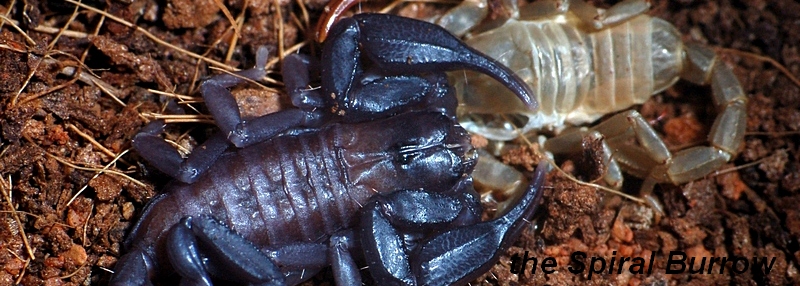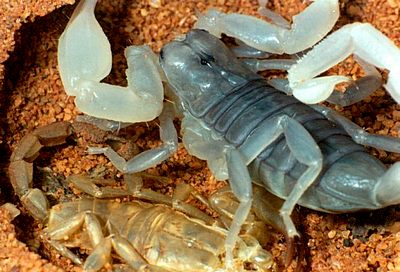
Growth and Ecdysis
Scorpions achieve growth in two major ways. Increase in body mass over time with ingestion of food brings about a small size increase as flexible membranes stretch. This method of growth has limitations due to the scorpions hardened(non-living) exoskeleton or cuticle. Expansion only occurs between the hardened sections where flexible membranes exist to allow movement and expansion of the main mesosoma(body). The mesosoma must expand to allow for the development of embryo's in females and also to allow expansion as food is ingested. This expansion comes about via the flexible pleural membranes, found between the top and bottom mesosomal plates. The remaining flexible membranes between sections is to allow for the articulated movement of the various body parts.
The second and most interesting method of growth comes about by shedding or ecdysis of the cuticle. To achieve major growth the scorpion must grow a new cuticle under the old, which will expand and help push the old cuticle off the body. An increase in internal body pressure helps to split the old cuticle from the area around the mouth parts and a little down the side of the anterior prosoma(head). With intermittent periods of activity and rest the scorpion manages to manoeuvre the old cuticle rearwards. This is a vulnerable period normally spent within closed quarters to keep out potential predators and also maintain the necessary climatic conditions; in Urodacus elongatus molting takes place in a sealed cell under a rock.
 |
Ecdysis - Urodacus elongatusGrowth in scorpions occurs in quantum leaps due to ecdysis (shedding) of the old rigid cuticle. Once the final adult stage is reached ecdysis no longer occurs in either sex. After ecdysis the new exoskeleton is quite soft making the scorpion vulnerable to predation or damage which is why scorpions block off their burrow (retreat) during this phase. |
The first ecdysis comes about whilst the young are still on mothers back. At this stage their exoskeletons are membrane like and tend not to fluoresce under uv, showing that the cuticle hasn't hardened or tanned. This may be due to the necessary water uptake from the mothers cuticle or possibly even diffusion of oxygen for respiration. There is a decrease in size at the first instar stage as the young consume the internal yolk supply present when born. Normal feeding is not possible at this stage as mouth parts are still unspecialised.
After the first instar molts it remains with its mother until the exoskeleton has completely hardened, at which time the various body parts have become specialised ready for a solitary existence. This post first molt time with mother varies between species, but ranges from a few days to 3-4 weeks. At this stage the hardened cuticle begins to fluoresce under uv light.
People who keep scorpions find ecdysis one of the most difficult stages for survival. Emulation of normal environmental parameters is critical for success. In the inset image we see a Urodacus elongatus that's undergone a molt in a sealed scrape beneath a rock(removed for observation). Without sealed conditions the scorpion may try to molt and fail or not molt at all. Note how the scorpions exoskeleton lacks pigmentation at this early post molt stage. In a week or so the cuticle will have hardened allowing the scorpion to return to normal activity.